Abstract
Skin-infiltrating lymphocytes (SIL) were isolated from skin biopsies of patients with hyperimmunoglobulin E (IgE) atopic dermatitis (AD) and expanded in vitro in the presence of IL-2 in combination with IL-4. Phenotypic analysis of skin-derived cells revealed the predominance of CD4+ T helper/inducer phenotype in SIL populations. In 3H-thymidine incorporation assays, SIL showed proliferation in response to IL-2, IL-3, IL-4, ionomycin (Io) + 12-o-tetradecanoyl-phorbol-13-acetate (TPA) and OKT3 + TPA. OKT4 with and without TPA did not induce proliferation. Tumour necrosis factor alpha (TNF-alpha) did not block proliferative responses of SIL to IL-2 and IL-4. Cultured SIL showed no cytotoxic activity against K562 and Jurkat target cells. Expanded skin-derived T cells were tested for their capacity to secrete several cytokines in vitro. SIL secreted significant amounts of IL-4, GM-CSF and TNF-alpha upon stimulation with mitogens but failed to secrete IFN-gamma. Io in combination with phorbol-ester induced the secretion of larger amounts of IL-4, GM-CSF, TNF-alpha and low amounts of IFN-gamma. The data indicate that SIL derived from AD lesions were defective in their capacity to secrete IFN-gamma but were enriched in T cells capable of producing IL-4 upon stimulation. The results support the possibility of a predominant 'TH2-like' cell-mediated immune response in lesional skin of AD patients.
Full text
PDF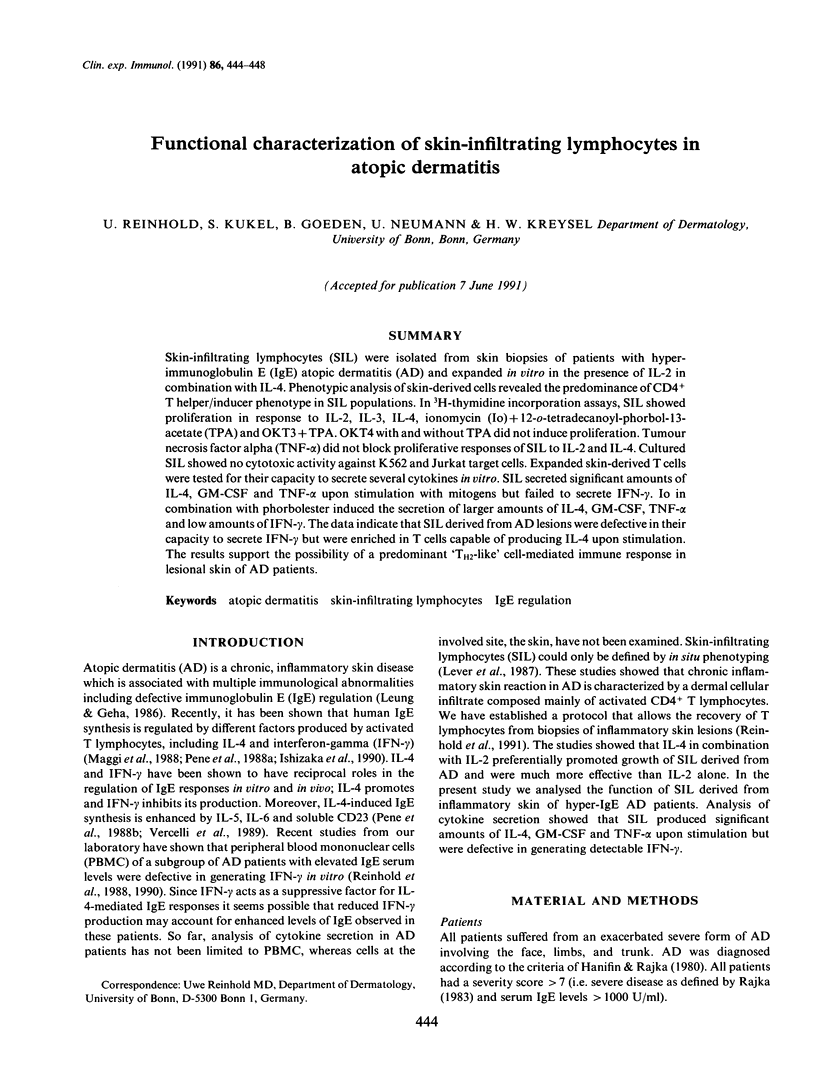
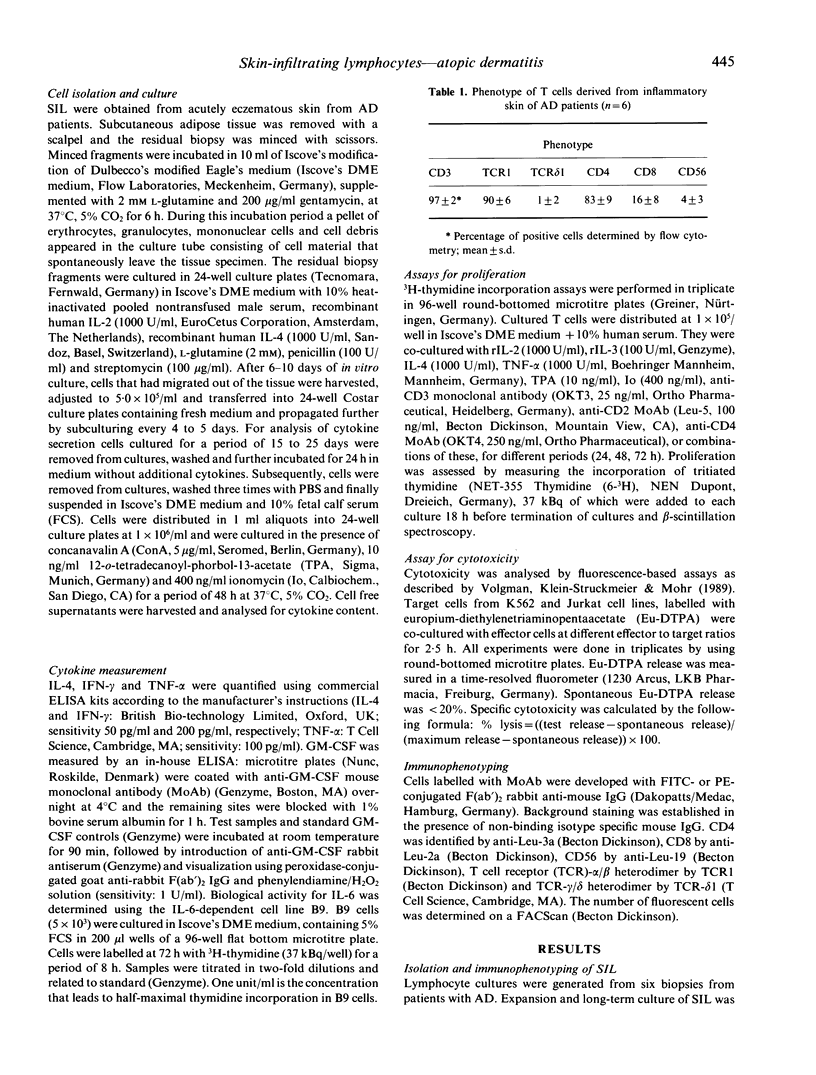
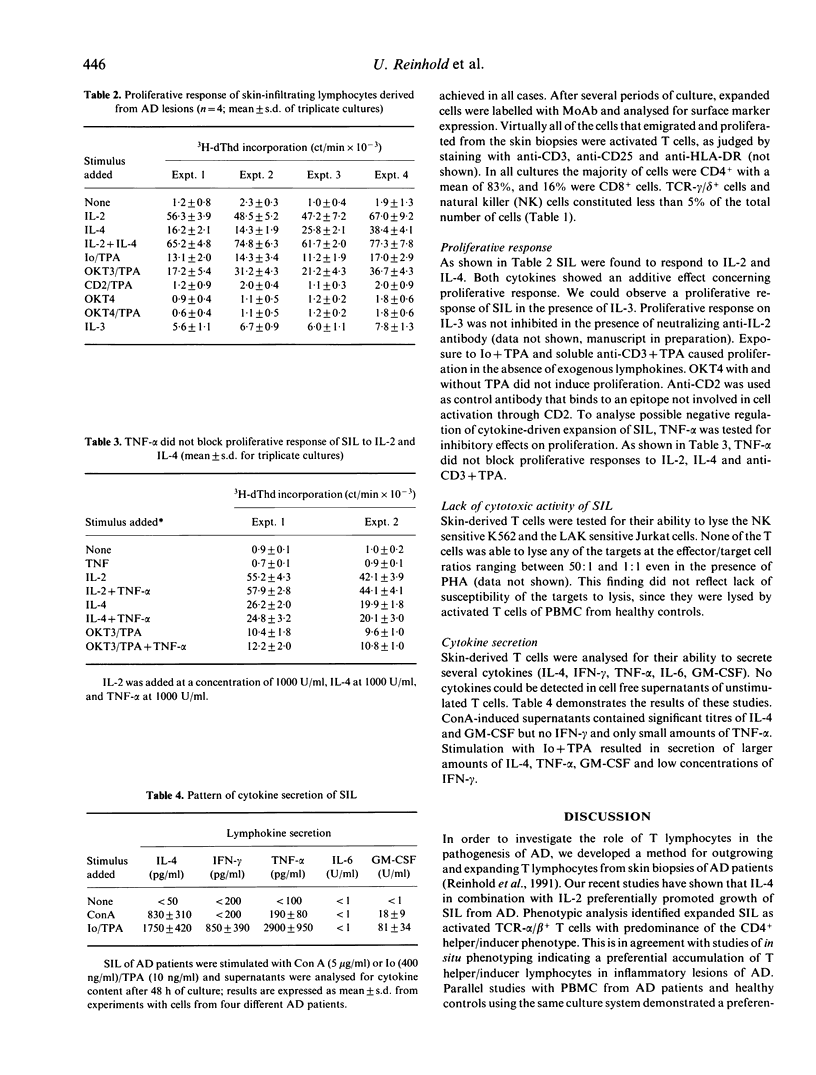
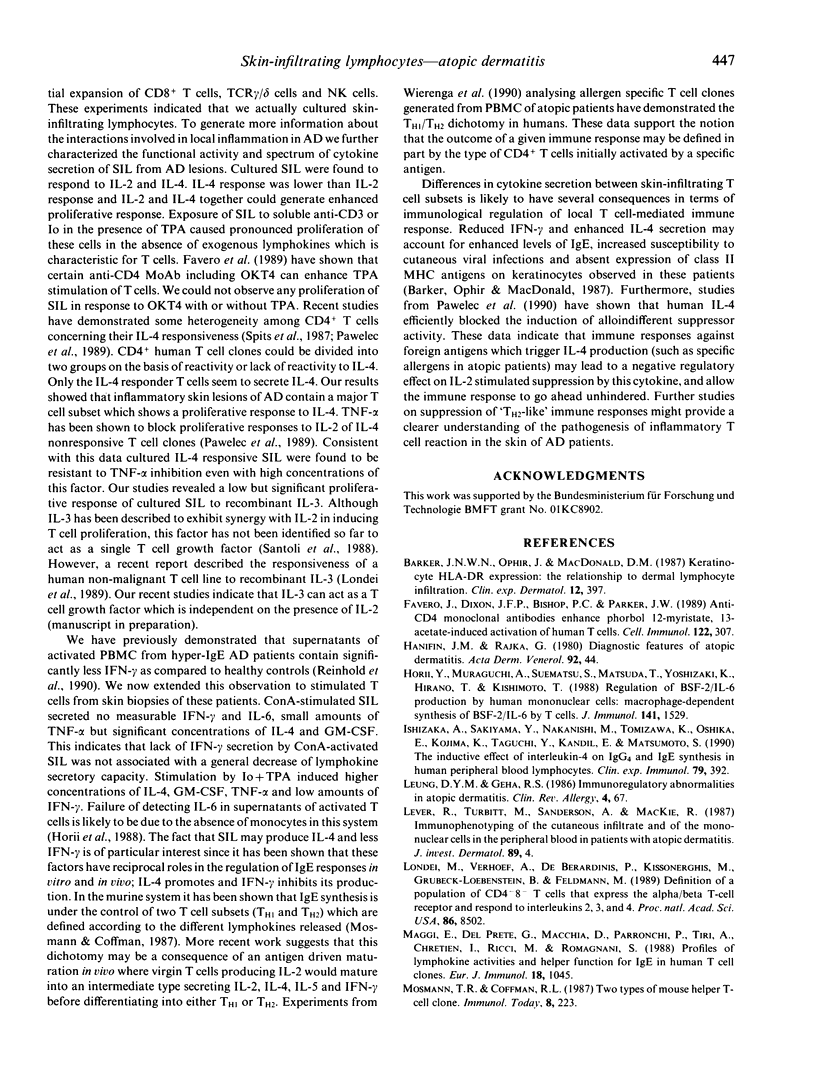
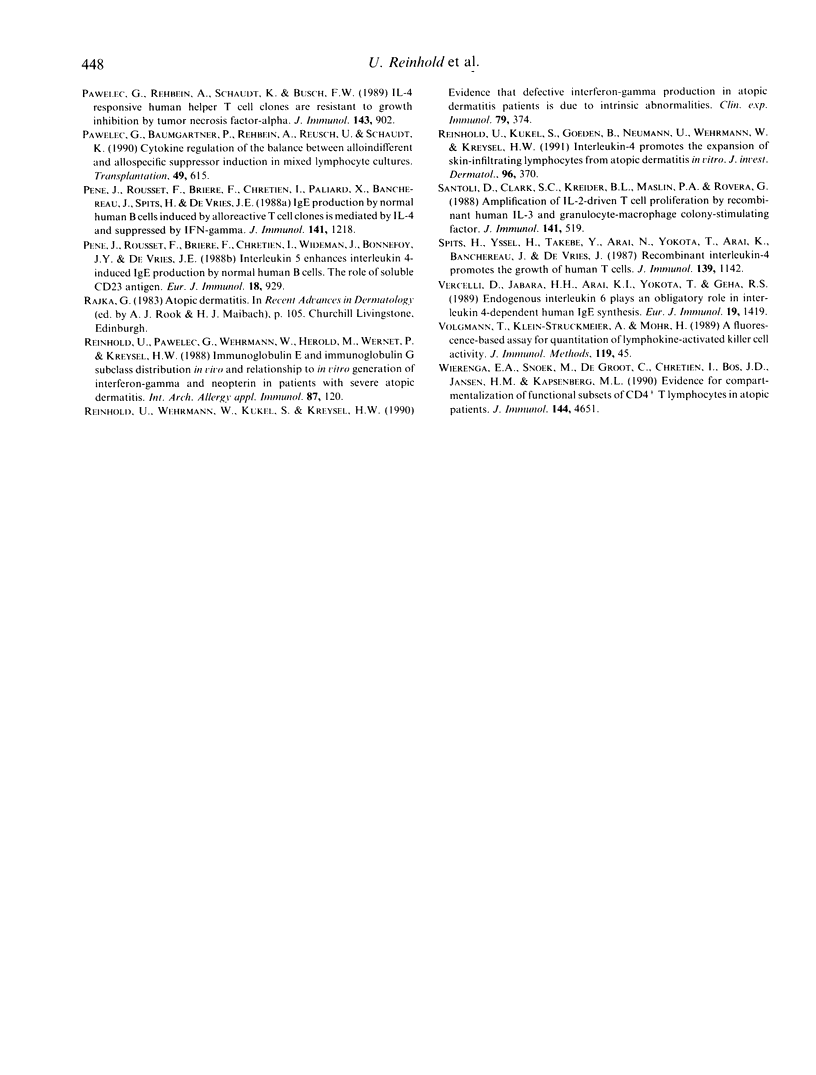
Selected References
These references are in PubMed. This may not be the complete list of references from this article.
- Barker J. N., Ophir J., MacDonald D. M. Keratinocyte HLA-DR expression: the relationship to dermal lymphocytic infiltration. Clin Exp Dermatol. 1987 Nov;12(6):397–399. doi: 10.1111/j.1365-2230.1987.tb01934.x. [DOI] [PubMed] [Google Scholar]
- Favero J., Dixon J. F., Bishop P. C., Parker J. W. Anti-CD4 monoclonal antibodies enhance phorbol 12-myristate, 13-acetate-induced activation of human T cells. Cell Immunol. 1989 Sep;122(2):307–318. doi: 10.1016/0008-8749(89)90079-8. [DOI] [PubMed] [Google Scholar]
- Horii Y., Muraguchi A., Suematsu S., Matsuda T., Yoshizaki K., Hirano T., Kishimoto T. Regulation of BSF-2/IL-6 production by human mononuclear cells. Macrophage-dependent synthesis of BSF-2/IL-6 by T cells. J Immunol. 1988 Sep 1;141(5):1529–1535. [PubMed] [Google Scholar]
- Ishizaka A., Sakiyama Y., Nakanishi M., Tomizawa K., Oshika E., Kojima K., Taguchi Y., Kandil E., Matsumoto S. The inductive effect of interleukin-4 on IgG4 and IgE synthesis in human peripheral blood lymphocytes. Clin Exp Immunol. 1990 Mar;79(3):392–396. doi: 10.1111/j.1365-2249.1990.tb08101.x. [DOI] [PMC free article] [PubMed] [Google Scholar]
- Leung D. Y., Geha R. S. Immunoregulatory abnormalities in atopic dermatitis. Clin Rev Allergy. 1986 Feb;4(1):67–86. doi: 10.1007/BF02991188. [DOI] [PubMed] [Google Scholar]
- Lever R., Turbitt M., Sanderson A., MacKie R. Immunophenotyping of the cutaneous infiltrate and of the mononuclear cells in the peripheral blood in patients with atopic dermatitis. J Invest Dermatol. 1987 Jul;89(1):4–7. doi: 10.1111/1523-1747.ep12579727. [DOI] [PubMed] [Google Scholar]
- Londei M., Verhoef A., De Berardinis P., Kissonerghis M., Grubeck-Loebenstein B., Feldmann M. Definition of a population of CD4-8- T cells that express the alpha beta T-cell receptor and respond to interleukins 2, 3, and 4. Proc Natl Acad Sci U S A. 1989 Nov;86(21):8502–8506. doi: 10.1073/pnas.86.21.8502. [DOI] [PMC free article] [PubMed] [Google Scholar]
- Maggi E., Del Prete G., Macchia D., Parronchi P., Tiri A., Chrétien I., Ricci M., Romagnani S. Profiles of lymphokine activities and helper function for IgE in human T cell clones. Eur J Immunol. 1988 Jul;18(7):1045–1050. doi: 10.1002/eji.1830180712. [DOI] [PubMed] [Google Scholar]
- Pawelec G. P., Rehbein A., Schaudt K., Busch F. W. IL-4-responsive human helper T cell clones are resistant to growth inhibition by tumor necrosis factor-alpha. J Immunol. 1989 Aug 1;143(3):902–906. [PubMed] [Google Scholar]
- Pawelec G., Baumgartner P., Rehbein A., Reusch U., Schaudt K. Cytokine regulation of the balance between alloindifferent and allospecific suppressor induction in mixed lymphocyte cultures. Transplantation. 1990 Mar;49(3):615–619. doi: 10.1097/00007890-199003000-00026. [DOI] [PubMed] [Google Scholar]
- Pène J., Rousset F., Brière F., Chrétien I., Wideman J., Bonnefoy J. Y., De Vries J. E. Interleukin 5 enhances interleukin 4-induced IgE production by normal human B cells. The role of soluble CD23 antigen. Eur J Immunol. 1988 Jun;18(6):929–935. doi: 10.1002/eji.1830180615. [DOI] [PubMed] [Google Scholar]
- Reinhold U., Kukel S., Goeden B., Neumann U., Wehrmann W., Kreysel H. W. Interleukin-4 promotes the expansion of skin-infiltrating lymphocytes from atopic dermatitis in vitro. J Invest Dermatol. 1991 Mar;96(3):370–375. doi: 10.1111/1523-1747.ep12466152. [DOI] [PubMed] [Google Scholar]
- Reinhold U., Pawelec G., Wehrmann W., Herold M., Wernet P., Kreysel H. W. Immunoglobulin E and immunoglobulin G subclass distribution in vivo and relationship to in vitro generation of interferon-gamma and neopterin in patients with severe atopic dermatitis. Int Arch Allergy Appl Immunol. 1988;87(2):120–126. doi: 10.1159/000234661. [DOI] [PubMed] [Google Scholar]
- Reinhold U., Wehrmann W., Kukel S., Kreysel H. W. Evidence that defective interferon-gamma production in atopic dermatitis patients is due to intrinsic abnormalities. Clin Exp Immunol. 1990 Mar;79(3):374–379. doi: 10.1111/j.1365-2249.1990.tb08098.x. [DOI] [PMC free article] [PubMed] [Google Scholar]
- Santoli D., Clark S. C., Kreider B. L., Maslin P. A., Rovera G. Amplification of IL-2-driven T cell proliferation by recombinant human IL-3 and granulocyte-macrophage colony-stimulating factor. J Immunol. 1988 Jul 15;141(2):519–526. [PubMed] [Google Scholar]
- Spits H., Yssel H., Takebe Y., Arai N., Yokota T., Lee F., Arai K., Banchereau J., de Vries J. E. Recombinant interleukin 4 promotes the growth of human T cells. J Immunol. 1987 Aug 15;139(4):1142–1147. [PubMed] [Google Scholar]
- Vercelli D., Jabara H. H., Arai K., Yokota T., Geha R. S. Endogenous interleukin 6 plays an obligatory role in interleukin 4-dependent human IgE synthesis. Eur J Immunol. 1989 Aug;19(8):1419–1424. doi: 10.1002/eji.1830190811. [DOI] [PubMed] [Google Scholar]
- Volgmann T., Klein-Struckmeier A., Mohr H. A fluorescence-based assay for quantitation of lymphokine-activated killer cell activity. J Immunol Methods. 1989 Apr 21;119(1):45–51. doi: 10.1016/0022-1759(89)90379-7. [DOI] [PubMed] [Google Scholar]


